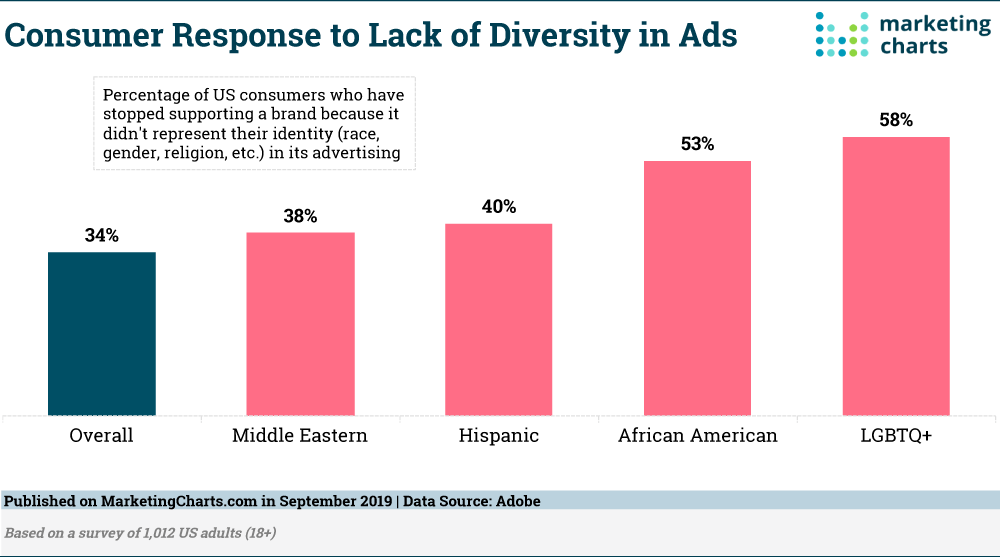Diversity in Advertising on the Rise


In 2020, issues around diversity, equity and inclusion rose to the forefront, in part because of questions about use of force during police interactions with people of color. In the wake of such issues getting increased attention, there has been a noticeable acceleration in marketing that in-cludes Black, Hispanic, Asian, Indigenous, and LGBTQIA+ people and people with disabilities in television commercials and other forms of advertising.


A concerted effort toward inclusion is happening both in front of the camera and behind the scenes in the advertising industry. And it means big change in a big business: In 2020, approximately $243 billion was spent in the United States on advertising, 40% of which went to television ads, according to Statista.
Last February, the trade journal Advertising Age canvassed Super Bowl LV advertisers about how they prioritized diversity and inclusion in the creation and production of their ads. “While some brands had very clear action steps and outlined specific ways they implemented these practices in the conceptual and production phases of its ads, many provided cookie-cutter mission statements that simply say they support the cause,” the article concluded.
“WOKE- WASHING”
Marketers need to be intent on providing more than just superficial lip-service — also dubbed “woke-washing” — to these groups. Alan Jope, CEO of Unilever — a company that helped pioneer purposeful marketing — warned that woke-washing can only serve to further imperil trust in advertising that’s already viewed with skepticism. “Purpose-led brand communications is not just a matter of ‘make them cry, make them buy,’” Jope stated at the Cannes Lions International Festival of Creativity in 2019. “It’s about action in the world.”
More needed to be — and is being — done. The effort to diversify minority representation in advertisements gained more traction in July 2020, when the Association of National Advertisers compiled a list of “Certified Diverse Suppliers for Marketing and Advertising” following a study that found that while 75 percent of ANA members had strategic plans in place to hire diverse suppliers for their overall organizations, only 40 percent had such strategies specifically for marketing and advertising services. The original list of just over 100 agencies and media, production, promotion, and research companies had grown to number 266 by April 2021.
The list also followed a June 2020 letter from the ANA and its diversity initiative, The Alliance for Inclusive & Multicultural Marketing (AIMM), the “ANA/AIMM Commitment to Equality, Inclusion, and Systemic Change.” The letter called for the development of an equitable creative supply chain through strategic investments in agencies, broadcasters, suppliers and producers owned or run by Black, Hispanic, Asian, Indigenous, and LGBTQ+ people and people with disabilities.
The AIMM Was established by the ANA in 2016 with a mission to “reverse the downward trend of multicultural and inclusive marketing by empowering marketers to accurately portray cultural diversity and richness in today’s marketing efforts.” Prominent board members of the Alliance include Anheuser-Busch U.S. Chief Marketing Officer Marcel Marcondes, Denny’s Chief Brand Officer John Dillon, Kellogg’s NA Chief Marketing Officer Gail Horwood, Nestlé Chief Marketing Officer Alicia Enciso and Procter & Gamble Chief Brand Officer Marc Pritchard.
BUYING POWER
As ethnic group populations grow in the U.S., so does their buying power, something of which the entertainment and advertising industries are acutely aware. According to Forbes, the buying power of Hispanic consumers totaled $1.5 trillion in 2020, an increase of 212% over the past decade. In addition, the combined buying power of Blacks, Asian-Americans and Native Americans reached $2.4 trillion and is increasing, Forbes said, citing figures from the University of Georgia’s Multicultural Economy Report. Almost all major ad agencies now have a division that focuses on multicultural marketing.
The increasing prominence of AIMM comes at a time when the targeting of ethnic communities by hate groups has been on the rise. AIMM’s #SeeAll initiative was created to “drive increased accurate representation of Multicultural and Inclusive segments in ads and programming by prioritizing the use of cultural insights in the content in order to connect with consumers at the heart, thus maximizing corporate growth.”
In addition, AIMM ran a public service announcement during last fall’s Primetime Emmys, featuring Billy Porter, Lin Manuel-Miranda, Isis King, Daniel Dae Kim, Nicole Scherzinger and Jamie Chung, designed to encourage Hollywood to do more to promote authentic cultural representation.
“Do you see me in this industry?” Miranda, who has Puerto Rican roots, asked in the PSA.
The actors called on leaders to showcase cultures correctly rather than rely on portrayals that abide by stereotypes: “Would you rather breathe life into stereotypes or stand up against them?” the stars challenged.
“We are more than a splash of color on your white canvas,” Porter emphasized.
In 2019, the AIMM in association with NBCUniversal created The Cultural Insights Impact Measure (CIIM), a metric that measures the incremental value of genuinely reflecting culture in marketing creative by identifying the impact and effectiveness of cultural insights in ads and programming on increased brand relevance, ad relevance, purchase intent lift, and loyalty.
Initial findings of the CIIM — which included a survey of 10,000 individuals across demographics including Hispanics, African-Americans, Asians, LGTBQ+, the Disabled community, and Non-Hispanic White — were released in September 2019 and showed that culturally-relevant ads are a key driver of brand affinity and purchase intent.


Source: AIMM
Results revealed that consumers who perceive ads as culturally relevant, compared to those who do not, are:
- 5 times more likely to learn more about the brand;
- 8 times more likely to recommend the brand to others;
- 6 times more likely to find the brand relevant to them;
- 3 times more likely to find the ad relevant to them;
- 7 times more likely to purchase a brand for the first time;
- 50% more likely to repurchase a brand they have bought in the past.
AIMM co-founder and President Carlos Santiago of Santiago Solutions Group, who led the study team, commented at the time, “Genuinely mirroring cultural values, in the eyes of consumers, boosts their recall, interest, net promoter scores and purchase intent. These findings present marketers with a paradigm shift as to how culture can optimize growth opportunities.”
CIIM can be used to test specific TV commercials. When a brand creates a new one, it can see how a diverse panel of consumers responds to the ad. For example, if the ad is aimed at a Hispanic audience, a general audience or a group not targeted would be asked fill out a questionnaire about the ad, as would an intended Hispanic audience.
NEW WAYS OF MEASURING
AIMM plans to release two new tools this year: a maturity model and a diversity index. The industrywide maturity model is expected to “help companies understand how to move forward” with their diversity & inclusion (D&I) efforts.
The diversity index, which AIMM is planning to launch this summer, will look at a variety of factors — marketing spend, CIIM scores, diversity figures about a company’s marketing structure and board of directors — to provide a holistic view of a company’s investment in multicultural marketing, MarketingDive reported.
AIMM co-founder Gilbert Dávila says that the CIIM maturity model and diversity index will enable companies see where they stand compared to their peers, and help motivate them to continue the progression.
“I’ve been in this business for 30 years, and there have been a lot of fluffy words thrown around anytime there is a crisis, I think with the hope that it will quickly fade away,” Dávila told MarketingDive. “But this time around is different. We’re seeing now a continued effort from CEOs from CMOs.”

